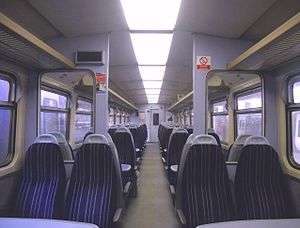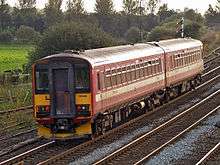British Rail Class 155
The British Rail Class 155 is a diesel multiple unit. These DMUs were built by Leyland Bus at Workington (incorporating some Leyland National bus components) between 1987 and 1988 as part of British Rail's replacement of its ageing first-generation diesel fleet. 42 units were originally built, however only 7 remain; the other 35 units were converted to Class 153 railcars.
| British Rail Class 155 Super Sprinter | |
|---|---|
Northern Rail 155347 at Leeds in 2007 | |
 The refurbished interior of a Northern Rail Class 155 DMU | |
| In service | 1987 - present |
| Manufacturer | Leyland Bus |
| Order no. |
|
| Built at | Leyland Bus, Workington[2] |
| Family name | Sprinter |
| Replaced | First generation DMUs |
| Constructed | 1987 - 1988 |
| Entered service | 1988[2] |
| Refurbished | 2006 - 2007 |
| Number built | 42 trainsets |
| Number in service | 7 trainsets |
| Formation |
|
| Diagram | |
| Fleet numbers |
|
| Capacity | |
| Operator(s) | |
| Depot(s) | Neville Hill[1] |
| Line(s) served |
|
| Specifications | |
| Car body construction | Steel[4] underframe. Powder coated steel body and roof with some aluminium non-structural panels. |
| Car length | 23.208 m (76 ft 1 3⁄4 in)[3] |
| Width | 2.700 m (8 ft 10 1⁄4 in)[3] |
| Height | 3.746 m (12 ft 3 1⁄2 in)[3] |
| Doors | Single leaf sliding plug[4] |
| Articulated sections | 2 |
| Wheelbase |
|
| Maximum speed | 75 miles per hour (121 km/h)[1] |
| Weight |
|
| Prime mover(s) | one per car, Cummins NT855R5[4][1] |
| Engine type | 14-litre turbo-Diesel |
| Cylinder count | 6 |
| Power output | 285 hp (213 kW) |
| Transmission | |
| Train heating | Warm air, hot water radiators[3] |
| Bogies | |
| Braking system(s) | Air/EP[4] |
| Safety system(s) | |
| Coupling system | BSI[6] |
| Multiple working | Classes 14x, 15x, 17x[4] |
| Headlight type | Fluorescent[3] |
| Track gauge | 1,435 mm (4 ft 8 1⁄2 in) standard gauge |
| Notes | |
| All cars in sets 155301-155335 converted to Class 153 | |
History and description

The Class 155 train is made up of two 23 metre coaches fitted with Cummins NT855R5 285hp engines and Voith transmission.[7][8]
The fleet was part of the "Super Sprinter" build (the other part of which was the Class 156 fleet - though only the latter carried the "Super Sprinter" branding) and was built by Leyland with a similar construction technique to the Pacers, with extensive use of Avdel rivets holding pre-formed panels together in a lightweight body on a welded floor assembly. The large number of windows makes the vehicles look unusually long, although the fact that the vehicles are very long for such a lightly built body has led to a slight sag being apparent in certain coaches.
Introduction was rapid, but teething troubles soon emerged. The units were the first BR DMUs with sliding-plug automatic doors which closed to provide a smooth bodyside rather than sliding back into the bodyshell (the system used with 150s and 151s). These doors did not work properly and there were reports of them opening while the trains were in use.[9] Consequently, the fleet was taken out of use and modified, with the 156s taking over their diagrams.[10]
Following rework the fleet performance improved substantially. An emerging requirement for replacement rural lines stock saw BR decide to convert the Regional Railways fleet into single-cars to replace the elderly 121 and 122 "Bubblecar" units. These single-car sets, introduced 30 years previously, had been threatened with withdrawal and replacement by the Pacer fleet, although the Pacers had proved to be unable to work the sharply-curving steeply-graded branchlines involved. Instead the Pacers were moved to replace a number of Class 150s, the 150s took over certain 156 diagrams, and the 156s took on the 155 services which were not handed over to the new Class 158s. The 155s emerged from the workshops as single car Class 153s, and were put to work augmenting two car units and on the quiet Cornish, Welsh, North-Western, Norfolk and Lincolnshire branch lines. They do not operate North of the Scottish border. However, West Yorkshire Passenger Transport Executive refused to allow the seven units which they owned to be converted, and these were merely modified to operate reliably in original form. The conversion to single car units was notable for not requiring any external doors to be moved, although this has led to the No.2 cab being unusually cramped, despite being extended into the vestibule area.
Surviving units
The previously mentioned seven remaining Class 155 units, which are numbered 155341 to 155347, were built in 1988 for West Yorkshire Passenger Transport Executive (WYPTE) for their MetroTrain services, and remain in service today in their original formation.[7] They are currently operated by Northern Trains. These were previously seen on Manchester Victoria to Leeds services but as of 2019 they are allocated to Hull and mostly operate routes in Yorkshire.
Model railways
In 2000 Hornby Railways launched its first version of the BR Class 155 in OO gauge.[11]
References
- Fox & Hughes 1994, pp. 32–33
- Marsden 2011, p. 118
- Vehicle Diagram Book No. 220 for Diesel Multiple Unit Trains (Railcars) (PDF). Barrowmore MRG. Derby: British Railways Board. 1982. DP248, DP249.
- "Class 155". The Railway Centre. Archived from the original on 9 March 2005.
- "The Northern Interim Franchise Agreement" (PDF). Bevan Brittan LLP. 26 March 2014. p. 78. Retrieved 22 April 2015.
- "System Data for Mechanical and Electrical Coupling of Rail Vehicles". Rail Safety and Standards Board. Archived from the original on 5 July 2008. Retrieved 5 January 2009.
- "The Class 150 Series of DMUs". 9 August 2013. Retrieved 12 June 2018.
- "Class 155 Super Sprinter DMU". www.traintesting.com. Retrieved 12 June 2018.
- "DMU Classes 153-159". www.angelfire.com. Retrieved 12 June 2018.
- "Class 155". Sprinters. Retrieved 12 June 2018.
- "Hornby BR Class 155 Sprinter". Hornby Railways Collector Guide. Retrieved 2 February 2020.
Sources
- Fox, Peter; Hughes, Barry (1994). DMUs & Channel Tunnel Stock. British Railways Pocket Book No.3 (7th ed.). Platform 5. ISBN 9781872524597.CS1 maint: ref=harv (link)
- Marsden, Colin J. (2011). Traction Recognition (2nd ed.). Ian Allan. ISBN 9780711034945.CS1 maint: ref=harv (link)
External links
| Wikimedia Commons has media related to British Rail Class 155. |